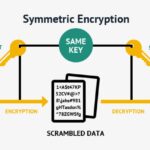As digital information continues to burgeon, the imperative for robust encryption methods in safeguarding this data intensifies. From the advent of simple substitution ciphers to contemporary algorithmic enigmas, encryption is an ever-evolving landscape. This evolution necessitates a proactive approach in both understanding the nature of these methods and implementing them effectively. To stay ahead as encryption methods evolve, one must familiarize themselves with the fundamentals, recognize emerging trends, and anticipate future directions.
Understanding the Fundamentals of Encryption
At its core, encryption is the process of converting plaintext into ciphertext, rendering the information unintelligible to unauthorized entities. The primary objective is to protect confidentiality, integrity, and authenticity across digital communications. Two predominant classes of encryption are symmetric and asymmetric cryptography. Symmetric encryption utilizes a single key for both encryption and decryption, while asymmetric encryption employs a pair of keys—a public key for encryption and a private key for decryption.
Additionally, hashing algorithms such as SHA-256 provide integrity checks, ensuring that data has not been altered during transmission. Knowledge of these basic concepts is critical, as the foundation of encryption must be well-understood to navigate its complexities effectively. Familiarity with historical ciphers can also lend insight into the iterative nature of cryptographic evolution.
Recognizing Trends in Encryption Practices
As technology advances, so too do the tactics employed by cyber adversaries. Consequently, it is incumbent upon security professionals to recognize prevailing trends in encryption practices. A burgeoning trend is the shift towards post-quantum cryptography, designed to secure data against the potential onslaught of quantum computing capabilities. Quantum computers, with their formidable processing power, pose an existential risk to traditional encryption methods. Hence, cryptographic algorithms that are resistant to quantum attacks, such as lattice-based cryptography, are under intense scrutiny and development.
Moreover, the implementation of encryption at various stages of data handling—from storage to transit—is becoming increasingly prevalent. End-to-end encryption in messaging applications, for example, signifies a broader paradigm shift towards safeguarding communications from eavesdropping. This paradigm not only boosts user confidence but also emphasizes the necessity of encryption as a fundamental right in the digital age.
An additional noteworthy trend is the growing intersection between artificial intelligence (AI) and cryptography. Machine learning algorithms are increasingly harnessed to analyze large datasets for vulnerabilities, dynamically adjusting encryption protocols in real time. This convergence of disciplines signifies a valuable tool at the disposal of security professionals aiming to stay a step ahead of emerging threats.
Anticipating Future Directions of Encryption
A pivotal approach to maintaining an advantage as encryption methods evolve lies in the anticipation of future directions. The NIST (National Institute of Standards and Technology) is currently engaged in the selection of post-quantum cryptography standards, signifying that widespread adoption is on the horizon. Awareness of such initiatives allows for timely implementation once new standards are finalized, ensuring that organizations remain compliant and secure.
Moreover, as the Internet of Things (IoT) continues its proliferation, the encryption of interconnected devices becomes paramount. The challenge here lies in the limited resources of many IoT devices, which complicates the implementation of robust encryption techniques. Future advancements may lead to lightweight cryptographic solutions that can adequately secure these devices without compromising performance.
Additionally, an increase in regulation around data protection, such as the General Data Protection Regulation (GDPR), forces organizations to consider encryption not merely as a protection mechanism, but as a legal necessity. It is essential to remain abreast of legislative changes, as non-compliance can result in substantial penalties. Understanding and adapting to these regulations will play a crucial role in shaping future encryption strategies.
Implementing a Proactive Encryption Strategy
To effectively navigate the evolving landscape of encryption, organizations must implement a proactive encryption strategy that incorporates the latest techniques, trends, and insights. Education and awareness must be a cornerstone of this strategy, as regular training on emerging technologies and threats can empower employees and cultivate a culture of security.
Conducting regular security audits and assessments is another crucial component of an effective encryption strategy. Such evaluations identify vulnerabilities that may be exploited by malicious actors, enabling timely updates to encryption methods. Moreover, staying engaged with professional communities and cryptographic research ensures that organizations remain informed about the latest innovations in the field.
Integrating automation into the encryption process can also streamline practices and reduce human error. Automated key management systems, for example, optimize the handling of encryption keys, rendering them less susceptible to theft or misuse. This will not only enhance security but also improve operational efficiency.
Conclusion
As encryption methods continue to evolve in response to technological advancements and emerging threats, it is incumbent upon organizations and individuals alike to remain vigilant. By understanding the fundamentals, recognizing current trends, and anticipating future developments, stakeholders can craft effective strategies to safeguard their data. Proactive measures, continual education, and a commitment to innovation will prove vital in staying ahead in the ever-changing world of encryption. Embracing this proactive stance is not merely advisable; it is necessary for maintaining security in an increasingly digital and interconnected environment.







Leave a Comment